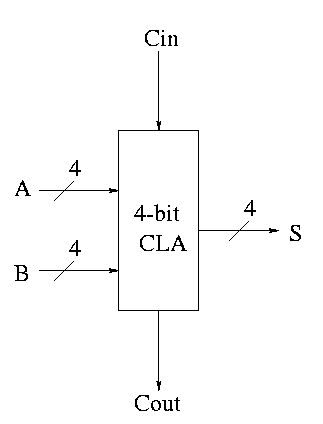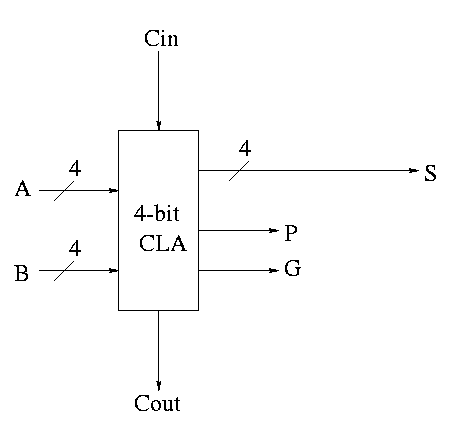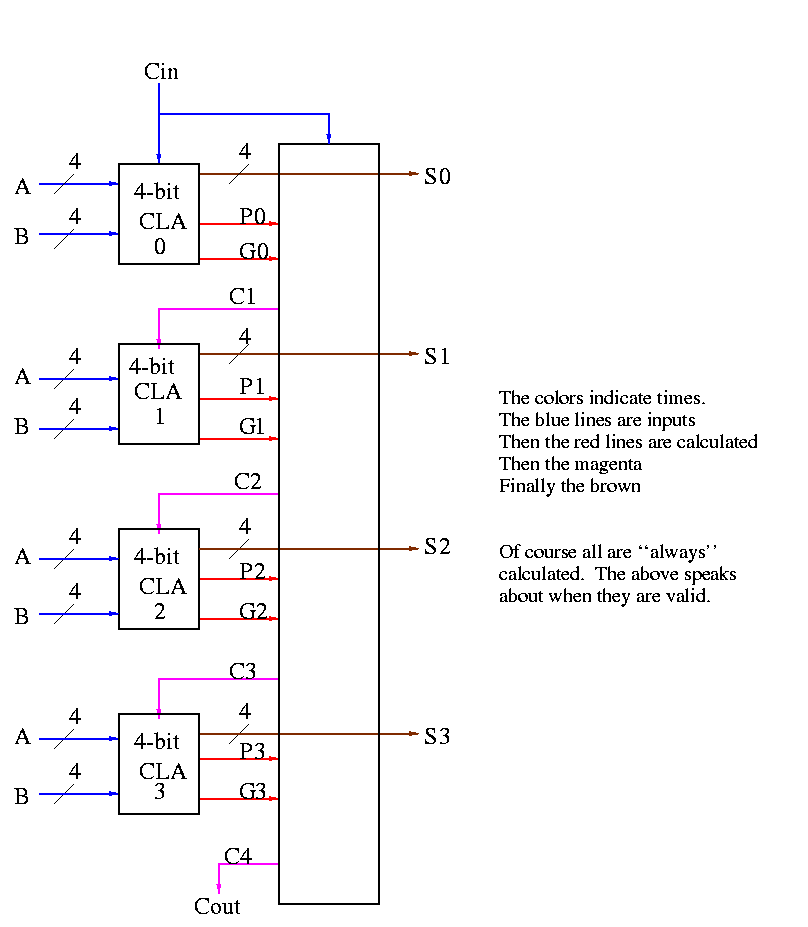
Adders
We did a ripple adder
We will now do the carry lookahead adder, which is much faster, especially for many bit (e.g. 64 bit) addition.
For each bit we can in one gate delay calculate
generate a carry gi = ai bi
propogate a carry pi = ai+bi
H&P give a plumbing analogue for generate and propogate.
Given the generates and propogates, we can calculate all the carries for a 4-bit addition (recall that c0=Cin is an input) as follows
c1 = g0 + p0 c0 c2 = g1 + p1 c1 = g1 + p1 g0 + p1 p0 c0 c3 = g2 + p2 c2 = g2 + p2 g1 + p2 p1 g0 + p2 p1 p0 c0 c4 = g3 + p3 c3 = g3 + p3 g2 + p3 p2 g1 + p3 p2 p1 g0 + p3 p2 p1 p0 c0
Thus we can calculate c1 ... c4 in just two additional gate delays (where we assume one gate can accept upto 5 inputs). Since we get gi and pi after one gate delay, the total delay for calculating all the carries is 3 (this includes c4=CarryOut)
Each bit of the sum si can be calculated in 2 gate delays given ai, bi, and ci. Thus 5 gate delays after we are given a, b and CarryIn, we have calculated s and CarryOut

So for 4-bit addition the faster adder takes time 5 and the slower adder time 8.
Now we want to put four of these together to get a fast 16-bit adder. Again we are assuming a gate can accept upto 5 inputs. It is important that the number of inputs per gate does not grow with the size of the numbers to add. If the technology available supplies only 4-input gates, we would use groups of 3 bits rather than four.
We start by determining ``supergenerate'' and ``superpropogate'' bits. The super propogate indicates whether the 4-bit adder constructed above generates a CarryOut or propogates a CarryIn to a CarryOut
P0 = p3 p2 p1 p0 Does the low order 4-bit adder
propogate a carry?
P1 = p7 p6 p5 p4
P2 = p11 p10 p9 p8
P3 = p15 p14 p13 p12 Does the high order 4-bit adder
propogate a carry?
G0 = g3 + p3 g2 + p3 p2 g1 + p3 p2 p1 g0 Does low order 4-bit
adder generate a carry
G1 = g7 + p7 g6 + p7 p6 g5 + p7 p6 p5 g4
G2 = g11 + p11 g10 + p11 p10 g9 + p11 p10 p9 g8
G3 = g15 + p15 g14 + p15 p14 g13 + p15 p14 p13 g12
C1 = G0 + P0 c0
C2 = G1 + P1 C1 = G1 + P1 G0 + P1 P0 c0
C3 = G2 + P2 C2 = G2 + P2 G1 + P2 P1 G0 + P2 P1 P0 c0
C4 = G3 + P3 C3 = G3 + P3 G2 + P3 P2 G1 + P3 P2 P1 G0 + P3 P2 P1 P0 c0
From these C's you just need to do a 4-bit CLA since the C's are the CarryIns for each group of 4-bits out of the 16-bits.
How long does this take, again assuming 5 input gates?
Some pictures follow.
Take our original picture of the 4-bit CLA and collapse the details so it looks like.

Next include the logic to calculate P and G

Now put four of these with a CLA block (to calculate C's from P's, G's and Cin) and we get a 16-bit CLA. Note that we do not use the Cout from the 4-bit CLAs.

Note that the tall skinny box is general. It takes 4 Ps 4Gs and Cin and calculates 4Cs. The Ps can be propogates, superpropogates, superduperpropogates, etc. That is, you take 4 of these 16-bit CLAs and the same tall skinny box and you get a 64-bit CLA.
Homework: 4.44, 4.45